
The bulletin from the Associated Press flashed across the computer in The Bakersfield Californian’s photo department a few minutes after 9 am on Friday, April 23, 1993. I was alone and raced down the stairs to the third floor newsroom, where a group of editors and reporters were chatting. The day was just getting started, coffee was brewing, receptionists were handling what seemed to be a never-ending stream of phone calls that poured in all day long in those pre-email and social media days. Nobody else had yet seen the bulletin. “Cesar Chavez has died in Arizona,” I blurted out. “The AP just moved a bulletin.” And with that, a chain of events that would lead to the largest team coverage project in my career, and likely in the newspaper’s history, were in play.
Chavez, of course, was a labor and civil rights titan, co-founder of the United Farm Workers of America and a figure whose national prominence approached that of the greatest civil rights crusaders of the era. And he was local. He lived in Keene, California, a small community nestled in the mountains just a 25-minute drive from downtown Bakersfield. He rose to prominence and worldwide fame after his United Farm Workers Association joined with Larry Itilong’s Agricultural Workers Organizing Committee, which organized Filipino farm laborers in Delano, another nearby community, about 30 miles north of Bakersfield. The merger of the two would lead to the eventual formation of the United Farm Workers. This was our story. Of course, it would also be the biggest story in the nation, but it was in our back yard. As far as we were concerned, it was ours.
But it didn’t start out well. Instantly, I knew what needed to be done. I needed to hook up with a reporter, get in a car and head to Chavez’ compound, called La Paz, in Keene. We could be there in less than half an hour. What was going on in that compound as word spread that the UFW president and beloved leader had died? Who knew? That’s why we needed to get there, and get there fast. Get there before the UFW’s finely-polished publicists and public relations people did. Get there before the other media did. Get there to capture the potential raw emotion, talk to people, get the color that is so crucial to a story of this magnitude. And then the editors got involved. Want to see a story go south in a heartbeat? Get the editors involved. I announced that I was heading to Keene, who was coming with me? Wait up, said the editors. We need to have a meeting. Wait up? We need to have a meeting? Good God, editors and their meetings. Don’t get me started on editors and their damn meetings. Too late, I’m started.
If you ever want to journey into journalism hell, sit in on an editors’ meeting. I worked in the business for 28 years, and never understood or figured out why editors had to have so many meetings. They were so brutally boring, sometimes droning on for more than an hour, that on the occasions I would fill in as photo editor and was involuntarily forced to sit in on them, I would look for excuses to get out of attending. My specialty was giving a photo assignment around the time of the meeting to myself, then telling the editors I couldn’t sit in, the assignment had to be shot and all the photographers were busy. It worked every time, thank God! I once worked with an editor who would read every word of every story he was putting in his section during the afternoon editors’ meeting. How I never rammed a pen through my eye just so an ambulance would come and get me out of there, I don’t know. I knew editors who wouldn’t take a piss without holding a two-hour meeting with their kidneys. I never understood why editors simply didn’t come out of their offices a few times a day and just talk to people about what was going on and what would be in the next day’s paper. No meeting necessary. As best I could figure, we all came from the era of the great television show “Lou Grant.” The editors’ meetings on “Lou Grant” were cool, Lou and Charley and Mrs. Pinchon waxing oh so poetically about the First Amendment and the right of the citizens to be informed, Rossi and Billie and The Animal eagerly looking to devour every pearl of wisdom their great and knowing leaders could impart. So maybe everybody wanted to be Lou Grant, I don’t know. But on this day, in those early moments, editors meetings were just about the dumbest idea anybody could come up with.
The first meeting was to decide which reporters to call in. Fine, I argued, but in the meantime, let me head up to Keene. No, wait, they said. Shit. The next meeting was to determine how we would cover the story. Fine, I argued, but in the meantime, we have to get up to Keene. No, wait, they said. Shit. Ah, finally, the reporters arrive. OK, now we can go, right? No, wait, they said. We now need a meeting to determine what the reporters’ coverage responsibilities will be. Shit.
Finally, the meetings were done. A plan was in place! It was fucking 1:30 pm, four and a half hours after the initial Associated Press bulletin moved. We arrived in Keene at 2 pm and were greeted by – guess what? – just about every Los Angeles media outlet, which had beat us to our own story by a good two hours or more. And they had gotten into La Paz, too! The UFW public relations folks were there now, and had cut off access to the compound. We waited a while and were finally allowed in to report the story. If I wasn’t pissed enough already, I would make an error in one of my cutlines, misidentifying a Chavez relative. The coverage in the next day’s paper would not reflect what I considered a major failure on the part of a newspaper considered one of the better mid-sized newspapers in California. The stories were good, the UFW did not restrict our access or attempt to control who we photographed or spoke with once we were allowed in. But I still wonder to this day, what could we have gotten had we responded immediately? What historic images presented themselves, only to flash away into oblivion, never to be seen? We’ll never know. We failed on that day. I failed on that day. We needed to do better. And we did.
As the Chavez funeral plans took shape, we found ourselves dealing with another newsroom issue. Celebrities. They were going to be at the funeral in a big way. Jesse Jackson was coming. The actor Edward James Olmos was coming. The comedian Paul Rodriguez. Former California Governor Jerry Brown. And, of course, the Kennedy family. The Kennedy family was a biggie, because of the late Sen. Robert Kennedy’s friendship and support of Chavez during his famous grape boycotts and hunger strikes. In The Californian’s newsroom, the word of the celebrities attending began to generate an excitement disproportionate to the story itself. It seemed the editors – including one very high-ranking editor – were more excited about which celebrities were attending than the news and historic value of the funeral. It wasn’t just me who felt this. Photo editor Casey Christie did, too, and we began a three or four day process of hammering the editors about what we perceived to be their over-excitement about the celebrities. The estimates were that 10,000 to 100,000 people were going to show for Chavez’s funeral. Our concern was that the editors were going to have us on a wild hunt for celebrities in the crowd. We wanted to photograph the funeral. The march. The people. The workers. We were photojournalists, not paparazzi. We didn’t care about the celebrities. We were especially concerned about Jesse Jackson. No person has ever been able to completely turn an event into a story about himself like Jesse Jackson. I don’t know if he does it intentionally or if it happens because the media is so infatuated by him. Never really thought about it. What I do know is the result is indisputable: when Jackson shows, he becomes the story and the story becomes the background. Casey and I wanted the story to be “Tens of thousands mourn Cesar Chavez.” Our fear was that the story was going to become “Jesse Jackson attends Chavez funeral.”
I don’t know if it was because they bought in to our argument or if they just wanted to shut us up – we were really hammering them – but we got a concession from the editors. They would not emphasize the celebrities. If we saw one, take a picture, but don’t spend any time searching them out. We were thrilled.
Bob Bentley was executive editor of The Bakersfield Californian for 12 years, from 1982 to 1994. His management style was confrontational, and his tenure was frequently marked by conflict as the majority of his staff returned his own, “in-your-face” style with a flourish. One thing the newsroom was not under Bentley was boring. Hard-nosed, strong willed editor. Equally hard-nosed, strong-willed reporters and photographers. You didn’t get fired for saying “fuck you,” you earned grudging admiration, so long as you were good at your job. Enough sparks flying in that newsroom that we didn’t need to buy our electricity from PG&E. But Bentley also had a plan. One of his first concerns was the lack of minority representation in the newsroom. When I arrived at The Californian in 1980, the editorial staff was almost 100 percent white. The pre-Bentley editors thought they made inroads when they hired their first bilingual reporter, a woman named Donna Reyes. Unfortunately, they didn’t bother to ask what the other language she spoke was, and when they attempted to send her into the fields to do a Spanish-language interview, learned that she was bilingual in English and Chinese. Damn, you gotta check those things out, don’t you think? Bentley began hiring Spanish speaking, Latino reporters. One of them, Leonel Martinez, even lived in labor camp housing, and brought an incredible knowledge and personal understanding of the farm worker culture to his reporting. Black reporters were hired, too. By the time of the Chavez funeral in 1993, the ethnic makeup of The Bakersfield Californian newsroom either equaled or came close to the ethnic makeup of the community. We were well positioned to effectively cover the funeral of Cesar Chavez.
Fourteen staffers – nine reporters and five photographers – were assigned to the funeral and last march of Cesar Chavez on Thursday, April 29, which began in Delano and concluded at the UFW’s Forty Acres headquarters, four miles away. The newspaper also rented out the top floor of a newly-built motel in Delano to serve as a temporary headquarters. I don’t know how many assistant editors, copy editors and page designers also worked on the coverage, but it’s a safe bet that around 25 of the newsroom’s then approximately 70 staffers worked on the Chavez funeral. We arrived in Delano just after dawn. Felix Adamo, Julie Rogers and I were assigned to cover the march and the thousands of mourners who would walk the four miles through the farm fields from Delano to Forty Acres. Ed Homich was assigned to cover the mass and service at Forty Acres, and Alan Ferguson covered the march, which stretched three miles in length, from the air. The reporters were Scott Forter, Leonel Martinez, Hugo Martinez-McNaught, Olivia Reyes, Rick Martinez, Rick Bentley, Tom Brisson, Susan Towers and Californian North Kern correspondent Donald Goertzen.
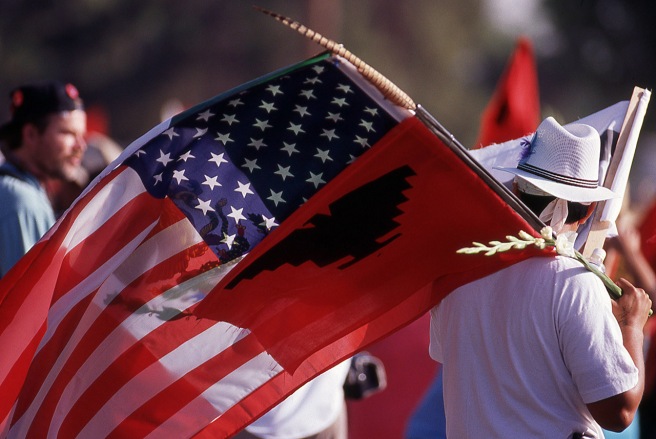
The early morning light was beautiful, warm and golden. Several hundred people milled about along Garces Highway in Delano, where the march would begin. Of course, in a few hours those hundreds would be thousands. But there were some nice pictures to be made. You don’t have to wait for an event to officially start to do good journalism. I noticed a Delano police officer holding a UFW flag, and the uniqueness immediately struck me. I don’t imagine too many Delano police officers held UFW flags in the 1960s as Chavez was organizing the farm workers. He was Sgt. Jose Roman, assigned to crowd control, and after I shot his picture, he gave me a great quote, just three words: “Everybody knew Cesar.” I struck up a conversation with a man working with a professional movie camera. He was Gregory Nava, the film director and screenwriter who had directed the critically-acclaimed film “El Norte” and would go on to direct “Selena” and “Mi Familia” and co-write “Frida.”
Then I spotted Dolores Huerta, walking with a few people. No media around. I had never met Huerta, and do not recall having photographed her. But I knew she was the co-founder, with Chavez, of the UFW. I moved toward her and knelt down as she reached over and removed a shoe, then replaced it with a tennis shoe. Holy crap! Dolores Huerta was putting on her tennis shoes for her final march with Cesar Chavez! And nobody was there except me. Could this be happening? She looked over and spotted me. She smiled and said “hello.” I said “hello.” And that was the first time I met Dolores Huerta. I was excited about the image I had just recorded, but couldn’t stay excited for long. The day was just getting started, there was much work to be done, who knows how many thousands of images were going to be made between the five of us?
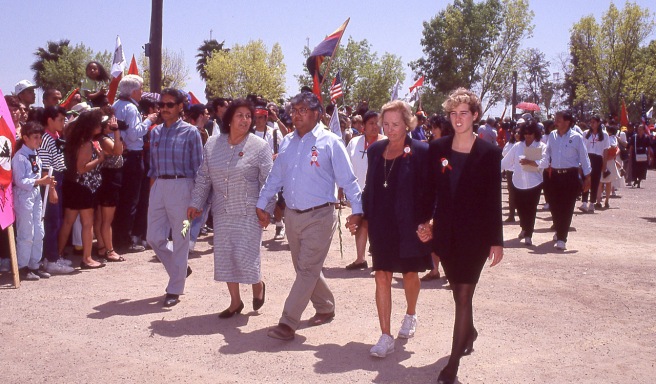
I walked the entire four miles of The Last March, along Garces Highway, through the fields where thousands upon thousands of workers Chavez became a hero to labored, to the Forty Acres compound. I’m sure I walked much more than four miles as I backtracked frequently to shoot pictures that I thought told the story of the day. Felix Adamo primarily remained at the front of the march, leaving me to work as sort of a rover, moving freely about the three-mile long stretch of marchers, estimated at 30,000.
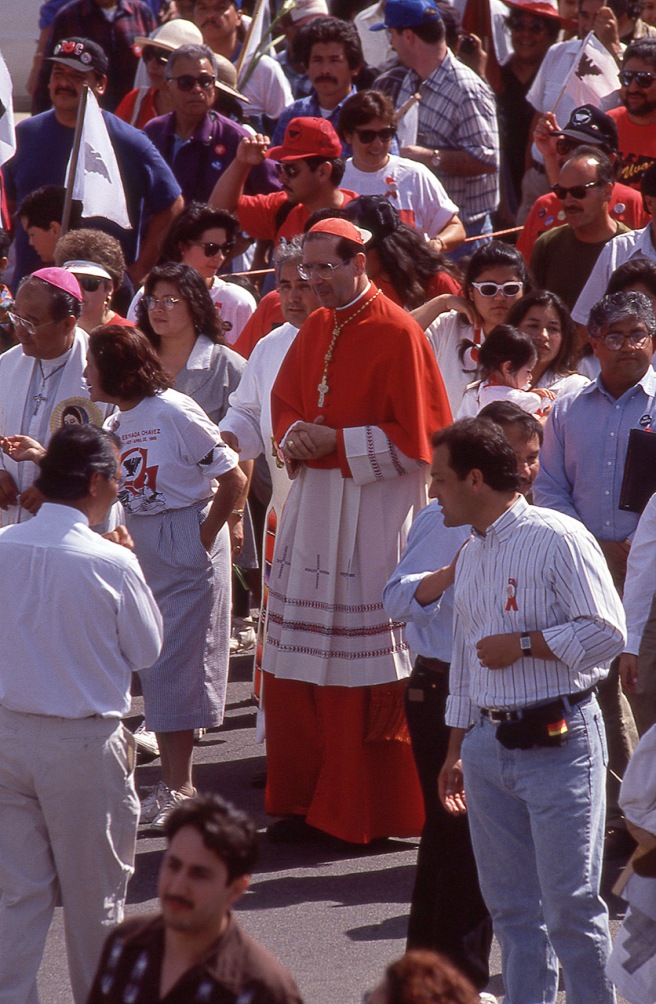
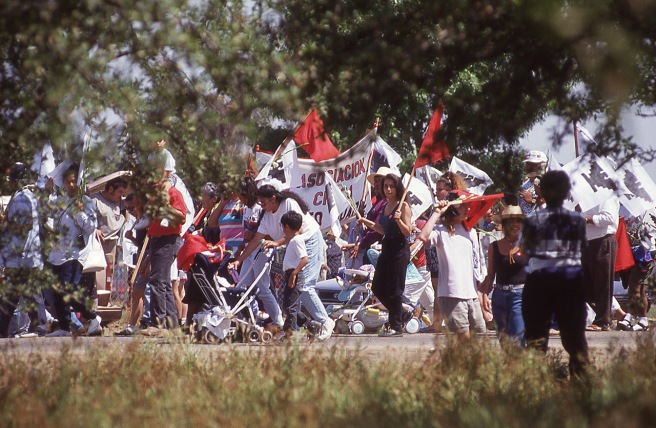
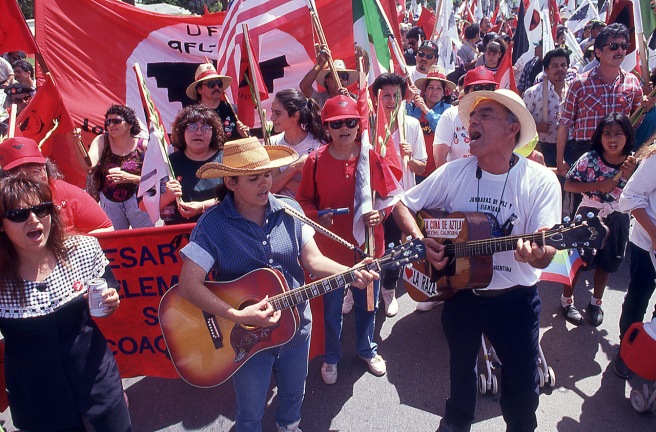
It was that freedom to roam that led me to Rebecca Rivera. I almost missed her, but she caught my eye. She was sitting alone in the shade of an orchard tree, an infant in her arms. I took some shots and then went up to speak to her. I was curious as to why she was sitting in the orchid and not marching. She told me she was from Delano, spent 20 years working in the grape vineyards and was dying of intestinal cancer and didn’t have the strength to march, but had to attend somehow. So she sat and watched, clutching her 2-month-old grandson, Andres. I knew I had recorded something special. It was the moment that would stay with me for the rest of the day, even as I continued to shoot, probably hundreds of images.
The Californian’s coverage of The Last March and funeral of Cesar Chavez was something special. Twenty photos would accompany 11 stories, quite a display for the pre-Internet days. Today we would likely run three or four times as many photos online, but for 1993, it was quite a feat. No doubt, the biggest team coverage I was ever involved in. The editors who I delightfully skewer at the beginning of this post held true to their celebrities promise. Three tiny mug shots of Jesse Jackson, Jerry Brown and Edward James Olmos were the only pictures that made the paper. The coverage was about the people, the march, the funeral of Cesar Chavez. My reward for my coverage of the funeral of Cesar Chavez would come the next morning. Diana Ledbetter was a server at my neighborhood Marie Callender’s, where I went every morning for my coffee. I had just sat down when she came up and said, “Damn you, John Harte, you made me cry all morning. That picture of the lady in the field holding her grandson broke my heart.” That made my day. Here are The Bakersfield Californian pages, presented in high resolution so that you can read the stories and view the pictures.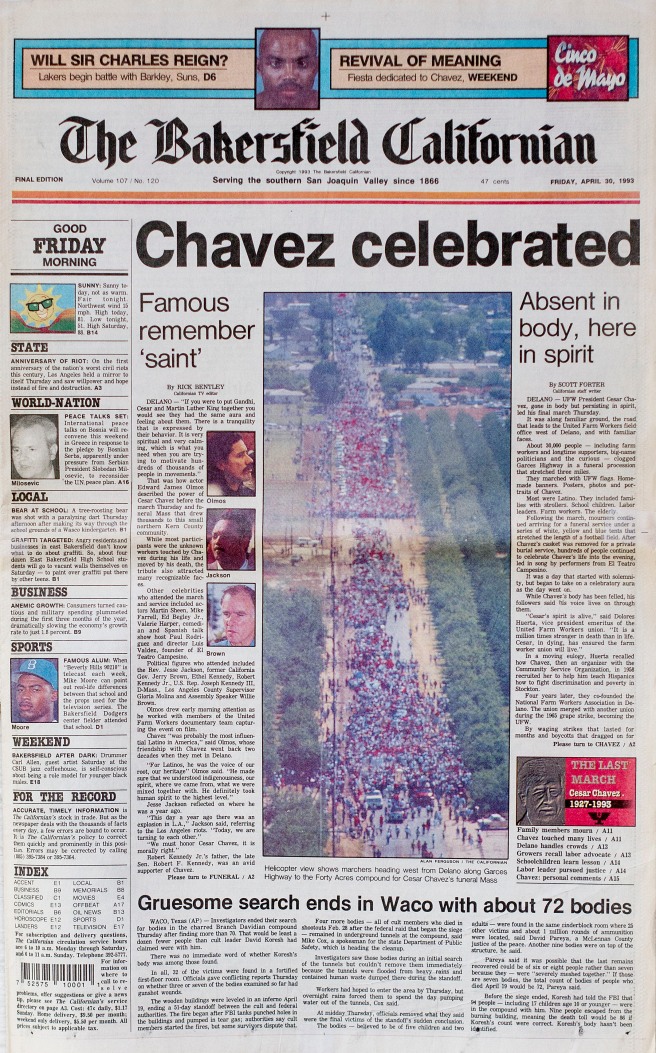
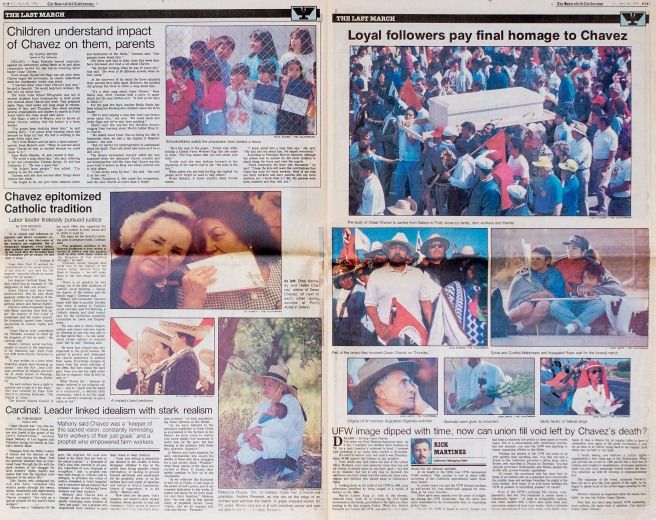
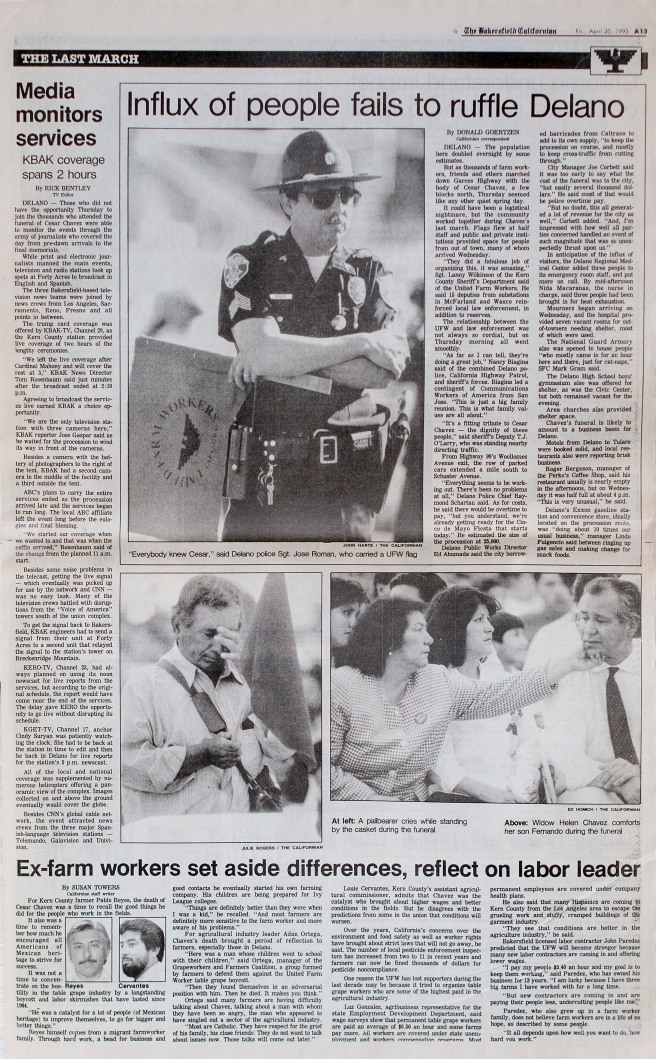
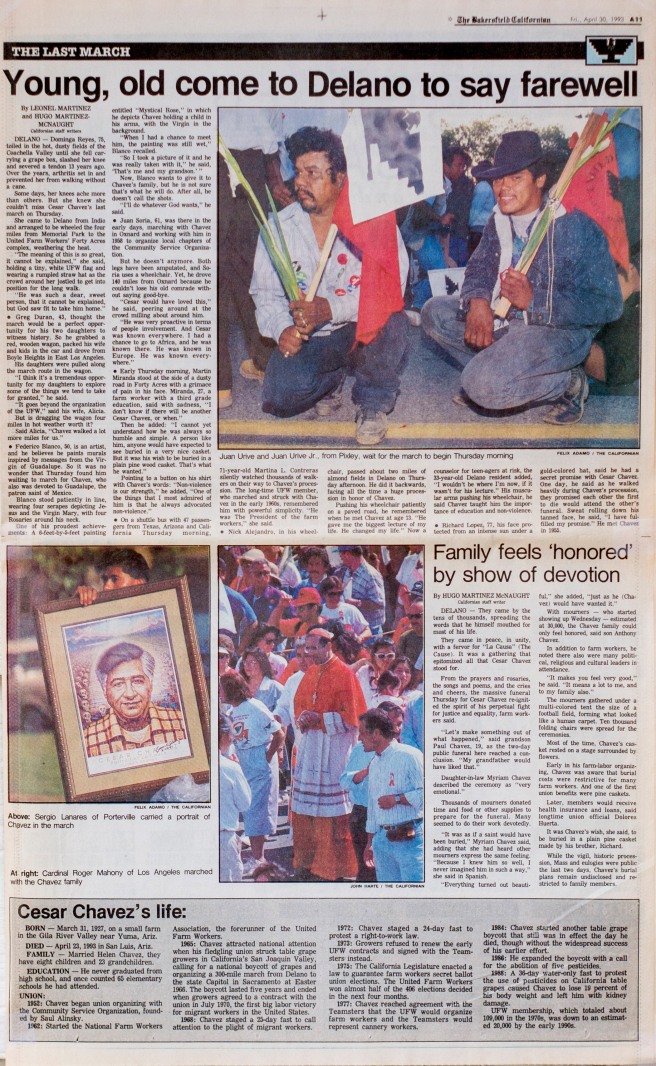 I would get to know Dolores Huerta over the years and photograph her frequently. She’s now 84 years old and lives in Bakersfield. She is, sadly, somewhat of an enigma here, a giant in the world of civil and women’s rights, a woman who received the Presidential Medal of Freedom from President Obama and consistently tops lists of the most admired women among the nation’s young Latino women, yet her stature, fame and impact resides outside her conservative hometown that doesn’t much welcome or appreciate labor leaders, Democrats and activists. This is a town that prefers to measure its heroes by their ability to sing country songs, drive race cars and toss footballs. Dolores Huerta occupies a special “hero” place with the likes of former United States Supreme Court Chief Justice Earl Warren or the little known Gretchen Knief. Warren, a Republican appointee of President Dwight Eisenhower, is still considered a traitor by some in these parts for his landmark Supreme Court civil rights rulings that changed the course and social landscape of American society in the second half of the past century. At least he has a school named after him. Knief, on the other hand, is almost completely unknown in Bakersfield. She’s the Kern County librarian who stood up to the Kern County Supervisors who banned John Steinbeck’s “Grapes of Wrath” in 1939. At the very least, she should have a library branch named after her. She doesn’t. I run into Dolores every once in a while, usually at community events, and most of the time I don’t take her picture, we just talk for a few minutes. I think she likes that.
I would get to know Dolores Huerta over the years and photograph her frequently. She’s now 84 years old and lives in Bakersfield. She is, sadly, somewhat of an enigma here, a giant in the world of civil and women’s rights, a woman who received the Presidential Medal of Freedom from President Obama and consistently tops lists of the most admired women among the nation’s young Latino women, yet her stature, fame and impact resides outside her conservative hometown that doesn’t much welcome or appreciate labor leaders, Democrats and activists. This is a town that prefers to measure its heroes by their ability to sing country songs, drive race cars and toss footballs. Dolores Huerta occupies a special “hero” place with the likes of former United States Supreme Court Chief Justice Earl Warren or the little known Gretchen Knief. Warren, a Republican appointee of President Dwight Eisenhower, is still considered a traitor by some in these parts for his landmark Supreme Court civil rights rulings that changed the course and social landscape of American society in the second half of the past century. At least he has a school named after him. Knief, on the other hand, is almost completely unknown in Bakersfield. She’s the Kern County librarian who stood up to the Kern County Supervisors who banned John Steinbeck’s “Grapes of Wrath” in 1939. At the very least, she should have a library branch named after her. She doesn’t. I run into Dolores every once in a while, usually at community events, and most of the time I don’t take her picture, we just talk for a few minutes. I think she likes that.
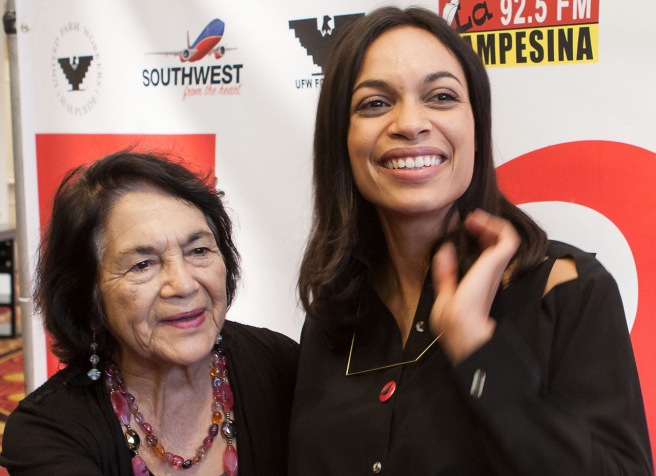
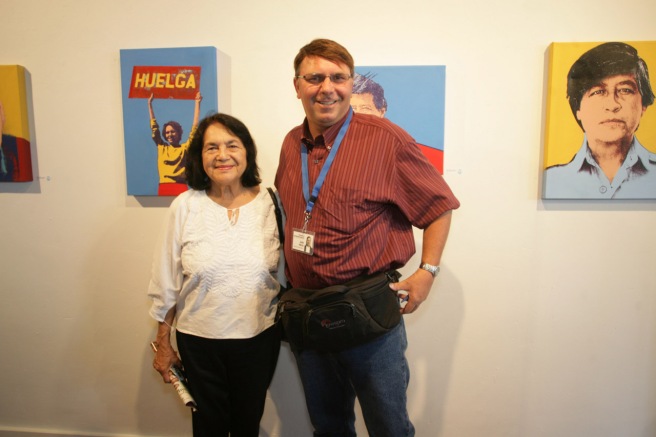
I learned a lesson that week of Cesar Chavez’s death and funeral, one that I would employ for the rest of my career. Trust your instincts as a journalist. Don’t involve editors until it’s too late for them to screw it up. Never again did I ask an editor if I should head out on a newsworthy story. I just did it, then when I got there, I’d call and let them know I was there. They would grumble a little, huff and puff, you know, “you should have told us first, but stay there and get the photos.” Bingo. And they don’t stay mad for too long. They probably forget all about it by the time they get to the next editors’ meeting.

I consider myself one of those farmworkers that is thankful to be part of a non violent revolution. From a farmworkers family. I was 16 years old when I began working full time in the grape fields. I don’t know where I would be now if Cesar and Delores hadn’t come to save me, us. Thank you for your story.
Thank you, Mary.
Cesar and Dolores touched the lives of many thousands of poor people and made us all better for the experience.
Yes! The editor meetings! The worst!
I’m so glad you guys were so relentless with your coverage opinion. I think it played a huge impact on how we covered events in the future, like when the Bobby movie premiered here.
Thanks for this inspiring blog about Cesar Chavez. It is nice that they have made a national holiday for him and his accomplishments. Looking forward to seeing more blogs from you!
Just what were his accomplishments then and what has changed today? The farming community is still rampant with illegals who are being taken advantage of by the growers all the while chanting how they pick our fruit and vegetables and without them we would starve. This is an excuse……..necessity has always been the mother of all inventions and this is how the cotton gin was invented. If we can create computers and the cyber world, surely we can build something to pick our growing fields. The answer is that there is no incentive for this and Liberals condone the practice for some obvious political reasons (2nd generation votes) as to keep them in power into perpetuity. Between affirmative action mandates, porous borders, White guilt, HUD housing and the welfare system, the landscape of this element has forever changed and burdened California to the breaking point. That in combination of a polarizing President, Barack Hussein Obama (who was largely elected by immigrants and Blacks) has forever ruined California specifically and the country as well. In my fifty something years as a born and bred Californian, I have seen much better days…….the state is so polarized and self segregated into communities where people come here from afar and form communities that look like a place from whence they came. This is not being part of America, the America that I grew up in, the America with all it`s faults back then (which I would much rather have than what we have today). The problem is that the majority of people coming here do NOT want to assimilate. What they want is to force us to learn their language, discriminate the work force by advertising “bilingual preferred” which everyone knows translates to, don`t bother applying unless you speak Spanish fluently as to be able to speak to the illegal workforce that the employer has hired – why else would this be? So……….yes, thank you Cesar for what you brought to California!
It must be exciting to work with what you love (even if it can be hell sometimes) and I am impressed by how much experience you have as a journalist. Thank you for sharing!
Very Inspirational
So inspiring.
Reblogged this on the plumbers union and commented:
Great story on so many fronts, Thanks
Great story on so many fronts, thanks
Great post
Reblogged this on Lokanampriya's Blog.
Beautifully written!
Nice knowledge u have got, bud.
Thank you
Fantastic Blog
Good luck
………………………….
My Blog
http://www.whatsapp-dp.com
@@@
Hi Dolores
hope doing well! !!!! I wanted to see if you remember delancey street when we would do security when you guys had events including Caesars funeral. it was back then. Just asking if there any pics of us and Caesar or you or the hearly or arturo. If their is how can I get them. I would like to have some to
educate my grand kids on the history of the movement. If possible
thank you for all you have done for us all your bravery all your suffering. and just having the biggest heart any human can ever have the movement is us is you is the chavez family .again thank you
( YES WE CAN )
Why cant I have your job?remember nothing is impossible